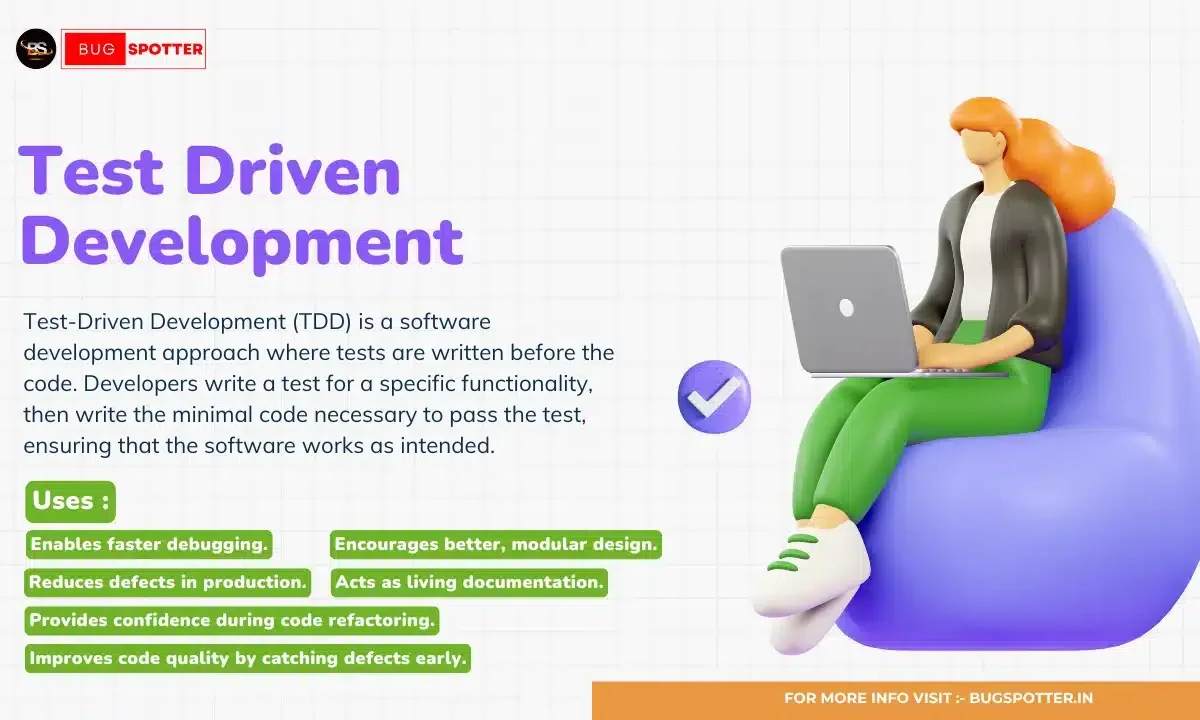Test Driven Development

Introduction
In the world of software development, writing clean, reliable, and bug-free code is the ultimate goal. But with the increasing complexity of applications, it’s easy to fall into the trap of writing code that works for now but might break later. This is where Test-Driven Development (TDD) comes in. TDD is a software development methodology that emphasizes writing tests before writing the actual code. In this blog post, we’ll explore the fundamentals of TDD, its benefits, and how it can help developers write better software.
What is Test Driven Development?
Test-Driven Development (TDD) is a development approach where you write automated tests for your code before writing the actual implementation. The process follows a simple yet powerful cycle:
- Red: Write a test that defines a function or improvement that you want to implement. Since the functionality doesn’t exist yet, the test will fail.
- Green: Write just enough code to make the test pass. Focus on making the test pass, not on optimization or elegant design at this point.
- Refactor: Clean up the code, improve its structure, and optimize it, ensuring that the test still passes after the changes.
This cycle—Red, Green, Refactor—is repeated throughout the development process
The TDD Cycle Explained
1.Red – Write the Test
The first step is to write a test that specifies what you want the code to do. This test is usually written before any implementation. At this stage, the test will fail because the code it’s testing hasn’t been written yet. The purpose here is to define what success looks like for the piece of functionality you’re about to implement.
Example: If you want to create a function to add two numbers, you’d first write a test that checks if the function correctly adds numbers.
def test_addition():
assert add(2, 3) == 5
2.Green – Write Just Enough Code to Pass the Test
The next step is to write the minimum amount of code necessary to make the test pass. Don’t worry about code structure, performance, or scalability at this stage. Focus solely on making the test pass.
Example:
def add(a, b):
return a + b
With this simple implementation, the test will pass, and you’ve moved to the green phase.
3.Refactor – Clean Up Your Code
After the test passes, it’s time to refactor. Refactoring involves improving the code, making it more efficient, readable, and maintainable without changing its behavior. The tests should continue to pass after the refactor, ensuring that no functionality has been broken during the cleaning-up process.
Example:
# Maybe you found a way to make the code more efficient or readable.
def add(a, b):
return a + b # Refactor if needed, but in this case, it's already clean.
Why Should You Use TDD?
Improved Code Quality
By writing tests first, TDD forces developers to think about how their code will behave before they start writing it. This results in better-designed and more maintainable code. The tests also provide an automated way to ensure that the code works as expected throughout the development lifecycle.
Fewer Bugs and Easier Debugging
Since tests are written before the code, any errors or issues are typically caught immediately after the code is written. This results in fewer bugs and a more robust application. Moreover, when bugs do arise, TDD helps pinpoint the root cause more quickly because the tests highlight where the code is failing.
Faster Development in the Long Run
It might seem like TDD slows down the initial development process since you’re writing tests before writing the code. However, in the long run, TDD speeds up development by reducing the amount of time spent on debugging, fixing errors, or dealing with legacy code that’s difficult to test.
Confidence in Refactoring and Maintenance
Having a comprehensive suite of tests provides confidence when refactoring or making changes to the codebase. Developers can confidently change or add new features, knowing that the existing functionality is protected by automated tests.
Better Documentation
TDD tests act as living documentation. Instead of reading through complex design documents or the code itself, other developers (or future-you) can simply run the tests to understand the expected behavior of the system. This makes onboarding and code reviews smoother and faster.
Advantages of Test-Driven Development
Early Bug Detection
By writing tests first, issues are detected early in the development process. This reduces the time spent on fixing bugs later, as tests ensure that each piece of functionality works as intended.
Code Reliability
With tests in place, developers can make changes to code with more confidence. TDD ensures that even as new features are added or existing ones are modified, the application continues to function correctly.
Encourages Simplicity
TDD encourages developers to write only the code necessary to pass the test, which results in simpler, more focused code. This can help avoid over-engineering and unnecessary complexity.
Continuous Integration Friendly
TDD integrates well with continuous integration (CI) pipelines. The automated tests run with each code change, ensuring that the system is always in a working state, reducing the risk of introducing errors.
Improved Design and Architecture
Writing tests before the code helps clarify the design and requirements from the outset. This results in better code structure and organization, as developers think about the desired behavior before implementing the solution.
Disadvantages of Test-Driven Development
Initial Learning Curve
TDD can be difficult for developers who are new to the practice. The process of writing tests before code may seem counterintuitive at first, especially for those accustomed to traditional development approaches. It may take time to adjust and fully embrace the methodology.
Slower Initial Development Speed
Writing tests before code can slow down development in the short term. Developers might feel they are spending more time on testing rather than building features. However, this slowdown is typically offset by fewer bugs and less rework later in the project.
Overemphasis on Unit Tests
TDD focuses heavily on unit tests, which can sometimes lead developers to neglect integration or end-to-end testing. Relying solely on unit tests may leave gaps in the coverage of the application’s overall functionality.
Not Ideal for All Projects
While TDD can be extremely useful for many projects, it’s not always the best fit. In cases of rapid prototyping or projects with unclear requirements, spending time on writing tests before the code may not be the most effective approach. TDD is more effective when there’s a clear understanding of the desired functionality.
Potential for Test Maintenance Overhead
As the codebase grows, the number of tests also increases. This can lead to maintenance challenges, especially if tests become outdated or need frequent adjustments to reflect changes in the application. Test suites need to be maintained and updated, which requires additional effort.
Best Practices for TDD
Keep Tests Small and Focused Tests should be short, specific, and focus on a single behavior. Small tests are easier to maintain and provide more useful feedback.
Write Readable Tests Tests should be easy to understand. Use descriptive names and clear assertions so that anyone reading the test can easily understand its purpose.
Refactor Often Don’t wait until the end of the project to refactor. Clean up your code frequently to keep it maintainable and avoid technical debt.
Use Mocks and Stubs When Necessary When testing complex systems, you might need to mock or stub dependencies to isolate the functionality you’re testing. This makes tests faster and more focused.
Latest Posts
- All Posts
- Software Testing
- Uncategorized





Categories
- Artificial Intelligence (5)
- Best IT Training Institute Pune (9)
- Cloud (2)
- Data Analyst (55)
- Data Analyst Pro (15)
- data engineer (18)
- Data Science (104)
- Data Science Pro (20)
- Data Science Questions (6)
- Digital Marketing (4)
- Full Stack Development (7)
- Hiring News (41)
- HR (3)
- Jobs (3)
- News (1)
- Placements (2)
- SAM (4)
- Software Testing (70)
- Software Testing Pro (8)
- Uncategorized (33)
- Update (33)
Tags
- Artificial Intelligence (5)
- Best IT Training Institute Pune (9)
- Cloud (2)
- Data Analyst (55)
- Data Analyst Pro (15)
- data engineer (18)
- Data Science (104)
- Data Science Pro (20)
- Data Science Questions (6)
- Digital Marketing (4)
- Full Stack Development (7)
- Hiring News (41)
- HR (3)
- Jobs (3)
- News (1)
- Placements (2)
- SAM (4)
- Software Testing (70)
- Software Testing Pro (8)
- Uncategorized (33)
- Update (33)





